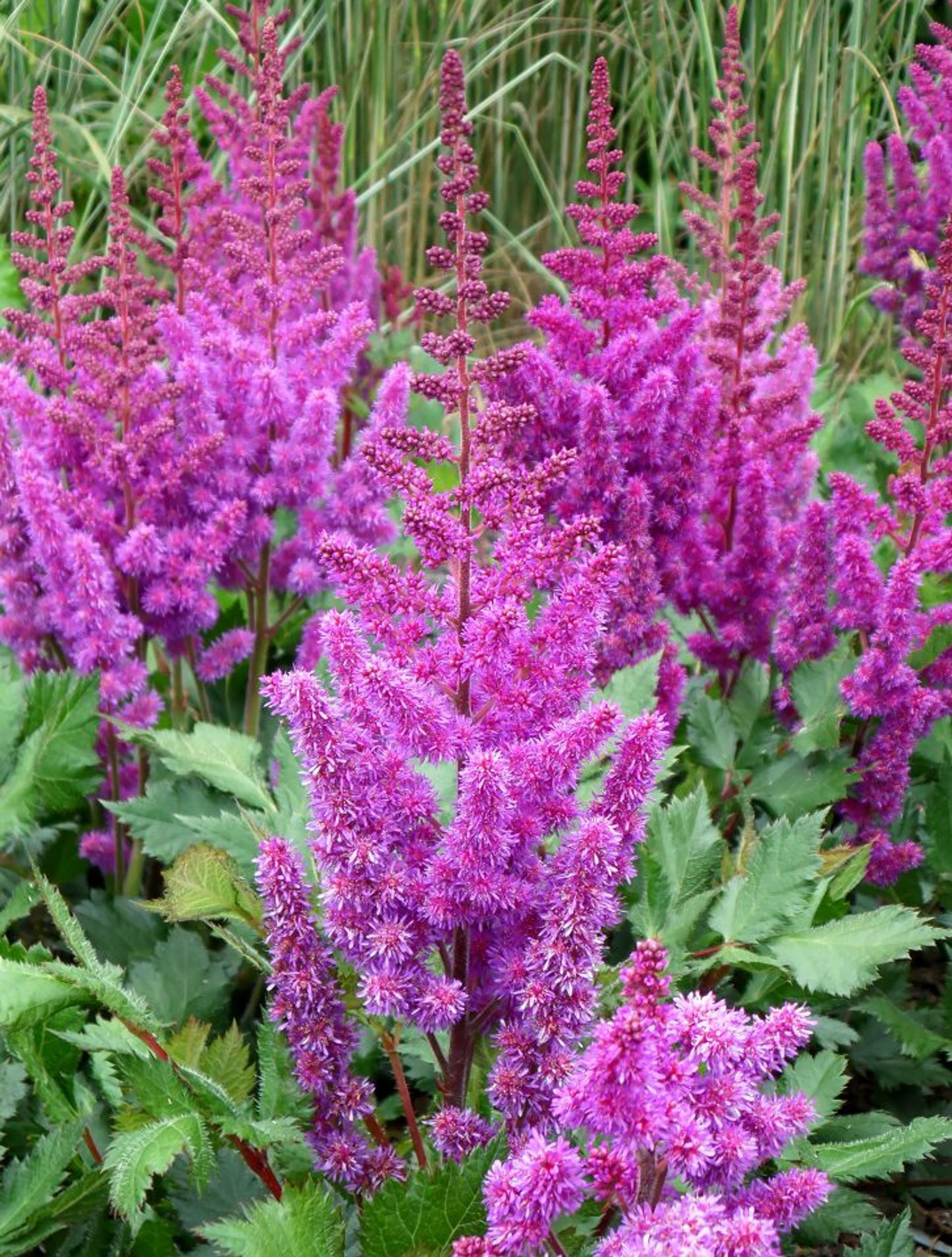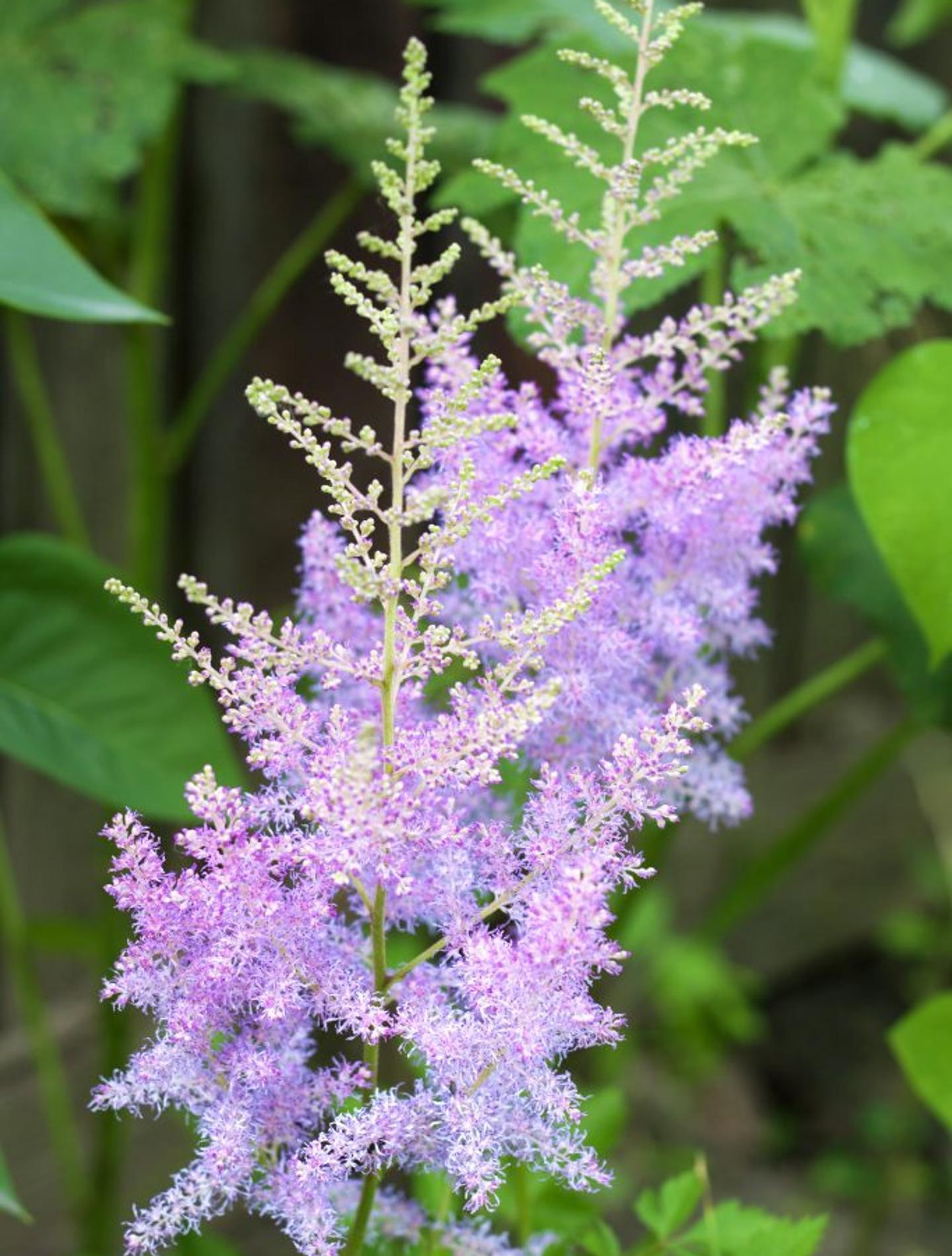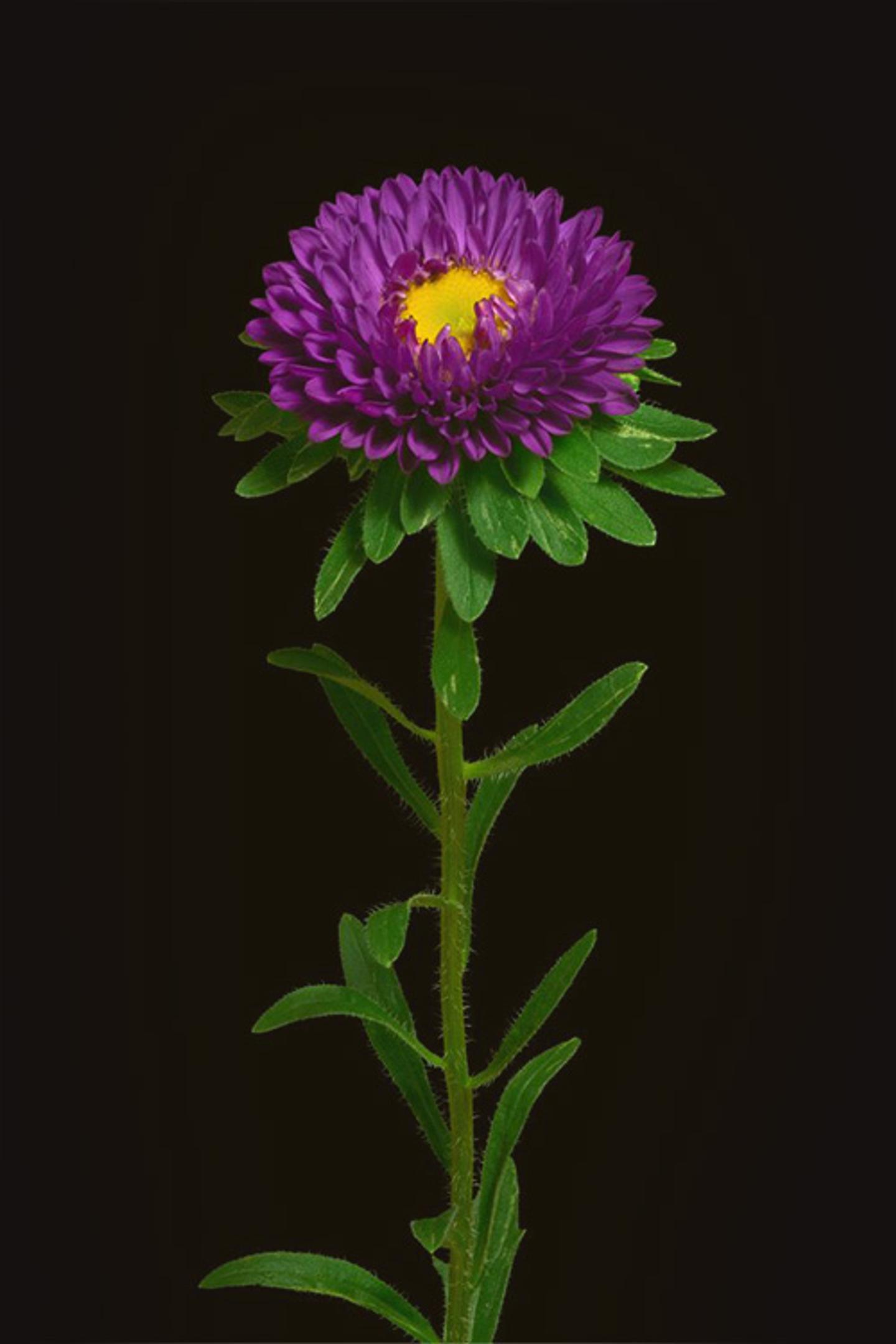Flower Meanings
Astilbe


The Meaning of Astilbe
The name Astilbe comes from the Greek word ‘a’ meaning without, and ‘stilbe’ meaning brilliance. Quite the plot-twist, huh? False goat’s beard, feather, and false spirea are all common nicknames for this brilliant, but apparently not so brilliant wildflower. Why ‘false goat’s beard,’ you ask? Go ahead and give this wild beauty one more quick look. [1]
Astilbe comes in a variety of soft, vintage hues, making them an idyllic addition to any wedding bouquet or centerpiece.
This lovely perennial grows in a plethora of unique hues, to name a few: pink, red, white, lavender, peach, all of which are perfect for a wedding of any season; if only they bloomed in the winter!
I know what you’re thinking, “This is a shade lover? No way!” Astilbe’s array of deep, vibrant colors only add to their classy yet dazzling appeal.
While the colors themselves don’t hold specific meaning individually, and Astilbe’s meaning is not as prevalent as many other flowers’ can be, its alluring blooms are known to be a symbol of patience and dedication to a loved one. The gifting of this flower is equivalent to a vow of patience and a promise to wait for one’s beloved, come what may. [1] This wildflower’s long lifetime directly reflects its symbolic, loving dedication; and its strong hardy nature represents the strength and power of one good love. Forget giving a bouquet of roses as a declaration of love!
What Does Astilbe Smell Like?
Some astilbe species are mildly fragrant whereas others feature a strong yet pleasant scent that will truly bring your garden to life. [7]

"When the Sun was high; Nestled with Fleabane; Pillowed in Stitchwort. Barely fern-like and feathery, just new, A small Astilbe, from somewhere."
Tom Aldrich
The History of Astilbe
With a whopping total of twenty engaging species, all belonging to the Saxifragaceae family, these elegant wildflowers are actually incredibly strong and rarely fall victim to disease. Discovered by German botanist George Arends, Astilbe’s original birthplace lies in the woody, mountainous peaks of Japan and China. This artsy perennial made its formal debut in the United States in the early 20th century.
Our friend Mr. Arends began to cross the first two species of Astilbe: japonica and davidii. The latter being the first pink variety in a sea of pure white. Arends continued to cross the species and their descendants until he raised bolder, more distinct variations. His first two prodigies were to be named ‘Queen Alexander’ and ‘Peach Blossom,’ still sold today. Arends’ dedicated breeding work resulted in the many different varieties of Astilbe we see today, from subtle dusty rose and plump, plumy blooms to the stunning, deep burgundy’s narrow, spiked blossoms.
Arends continued to cultivate this striking perennial during the 1920s and 30s. His most popular cultivar, released in 1933 with the name ‘Fanal,’ remains the most popular variance of Astilbe to this day. [2]
Astilbe’s Most Popular Varieties
Rheinland: The earliest to bloom, Rheinland often comes to life alongside Bleeding Hearts and Columbines in late spring. These feathery, bright pink blooms spring off of vibrant reddish stems.
Astilbe chinensis var. pumila (Dwarf Chinese Astilbe): In the late summer to early fall, when the colors of summer begin to fade, pumila takes the stage. It’s tall lilac spires shine bright, waving their final goodbye to summer’s comforting warmth. Chinensis is the only variety of Astilbe that is stoloniferous, spreading out at its base to create a bed of soft green leaves.
Astilbe arendsii ‘Fanal’: ‘Fanal’ has been cultivated since the 1930s, yet remains one of the finest red varieties, with its clusters of huddled ruby flowers over spiky crimson-tinged foliage. This particular bloom will have you daydreaming of a crisp fall morning and steaming cup of hot cocoa.
Astilbe simplicifolia ‘Sprite’: One of the most popular garden varieties, ‘Sprite’s’ luminous sprigs of creamy pink hover over lush, glossy foliage. These star-shaped blooms peak in July and continue to strut their stuff straight into August. [3]
DID YOU KNOW - Astilbe Fun Fact
These beautiful flowers will not only attract butterflies, but will also attract bees, moths, and hummingbirds. [4]

How to Grow Astilbe
Widely varying in shape and size, Astilbe can grow from six inches to five feet tall, making them the perfect addition to any outdoor garden or table arrangement.
Planting: Astilbe requires light to moderate shade; these tough guys will burn in full sun, so be careful! They prefer soils that provide average to slightly below average moisture. Be sure that your soil drains well and doesn’t puddle. Beware: dry soil can be fatal to these not so little guys!
Pro-tip: Use peat moss, perlite, and coarse sand to improve soil drainage.
While you can plant Astilbe seeds, it is more effective to plant divisions from other Astilbe plants. In this case, seed-born plants tend to be short-lived and difficult to germinate. It’s easiest to start with a plant or a division, as even a small plant will fill out quickly and perform very well in its first year of life. Plant your divisions in the spring or the fall about one to three feet apart, depending on the variety.
To prolong your Astilbe’s foliage, provide shade from any hot afternoon sun.
Gentle morning sun will surely do the trick. While Astilbe can grow in deep shade, they will not flower as much as they would in moderate shade. [5]
These shade-garden secret weapons will add vibrant, lively bursts of color to the even shadiest of places.
These perennials are incredibly reliable on their own, but they do benefit from being divided every few years. Doing so will regenerate your plant as well as increase your stock! [6] Divide them in the autumn after flowering or early spring.
We know what you’re thinking, there’s no way this plant is so low maintenance, but we’re here to tell you, it truly is. Astilbes are relatively trouble-free in terms of pests as well. Pests don’t really seem to like these puffy blooms (crazy, right?). Perhaps they are too feathery for their liking? You won’t see us questioning it!
DID YOU KNOW - Astilbe Fun Fact
Astilbe makes a great companion when planted with other shade tolerant plants, such as Hellebores and Hosta. [4]

How to Care for Astilbe
Outdoor Astilbe:
These perennials may be considered wildflowers, but remember to keep an eye on them nonetheless. Be sure they are moist and water accordingly if it doesn’t rain, watering deeply as opposed to a daily sprinkling.
Pro-tip: Provide your Astilbes with a balanced diet of organic fertilizer in the spring; they’ll eat it right up, trust us.
Astilbe will spread quickly, forming broad clumps. Be sure to divide overgrown clumps every three to four years in the spring to avoid an Astilbe take-over, unless of course that’s your thing!
Indoor Astilbe:
Astilbe makes the perfect stand-alone arrangement for your dining room table, coffee table, or even your bedside table if we’re getting fancy!
Go ahead and clip off a stem of those bad boys and bring em’ on in!
Pro-tip: Be sure to cut the stem at an angle using a pair of clean, sharpened sheers to avoid crushing the stem, allowing for maximum water intake to your blossoms.
Your blooms should have swollen, colorful buds to ensure the longest indoor life possible. [5]
Recut the stems and replace the water with fresh, cold water every other day to keep your Astilbe looking and feeling their very best.
When to Send Astilbe as a Gift
Use Astilbe as a fluffy filler or allow it to be the star of the show! As a symbol of promise, Astilbe makes the perfect filler for any wedding bouquet or centerpiece with its bold colors, full blooms, and strong stems fit to hold up even the most delicate flower. Astilbe’s vintage hues, particularly the muted pink and creamy white varieties for summer, or dark burgundy for fall, pair beautifully with roses and soft, downy dahlias or hydrangeas, ensuring your bridal bouquet is just as elegant as you are. Pro-tip: Use Astilbe as a replacement for leatherleaf in your groom and groomsmen’s boutonnieres for a unique twist! Astilbe isn’t just perfect for weddings, but Mother’s Day as well! Add volume, texture, and a rustic wildflower look to any arrangement or cut bouquet for Mom!

References:
- 1 - Holex
- 2 - Astilbe Collection
- 3 - Garden Design
- 4 - atozflowers.com
- 5 - almanac.com
- 6 - Gardeners World
- 7 - Home Stratosphere
Flower Meanings — keep discovering

Amaryllis
These big beautiful blooms may be a holiday favorite, but they’re actually derived from a group of tropical plants from Central and South America.

Anemone
No, not the one under the sea! We prefer the one in the garden *wink wink*.

Anthurium
Also known as laceleaf, anthurium is a stunning flowering pant of about 1,000 different species, and the largest genus of the arum family, Araceae. Some other common names of this beautiful bodacious bloom include tailflower and flamingo flower.

Aster
A part of the daisy family, aster is an ancient bloom that has been around for thousands of years, and you better believe it’s got a story to tell!

Amaryllis
These big beautiful blooms may be a holiday favorite, but they’re actually derived from a group of tropical plants from Central and South America.

Anemone
No, not the one under the sea! We prefer the one in the garden *wink wink*.

Anthurium
Also known as laceleaf, anthurium is a stunning flowering pant of about 1,000 different species, and the largest genus of the arum family, Araceae. Some other common names of this beautiful bodacious bloom include tailflower and flamingo flower.

Aster
A part of the daisy family, aster is an ancient bloom that has been around for thousands of years, and you better believe it’s got a story to tell!
Ready to send beautiful flowers?
Our guided experience helps you send a one-of-a-kind arrangement perfect for every occasion.
Send Flowers